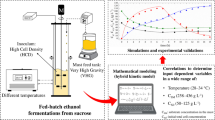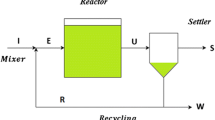Abstract
Experiments of continuous alcoholic fermentation of sugarcane juice with flocculating yeast recycle were conducted in a system of two 0.22-L tower bioreactors in series, operated at a range of dilution rates (D 1 = D 2 = 0.27–0.95 h−1), constant recycle ratio (α = F R /F = 4.0) and a sugar concentration in the feed stream (S 0) around 150 g/L. The data obtained in these experimental conditions were used to adjust the parameters of a mathematical model previously developed for the single-stage process. This model considers each of the tower bioreactors as a perfectly mixed continuous reactor and the kinetics of cell growth and product formation takes into account the limitation by substrate and the inhibition by ethanol and biomass, as well as the substrate consumption for cellular maintenance. The model predictions agreed satisfactorily with the measurements taken in both stages of the cascade. The major differences with respect to the kinetic parameters previously estimated for a single-stage system were observed for the maximum specific growth rate, for the inhibition constants of cell growth and for the specific rate of substrate consumption for cell maintenance. Mathematical models were validated and used to simulate alternative operating conditions as well as to analyze the performance of the two-stage process against that of the single-stage process.






Similar content being viewed by others
Abbreviations
- D :
-
Dilution rate (h−1)
- D 1 :
-
Dilution rate for the first reactor (h−1)
- D 2 :
-
Dilution rate for the second reactor (h−1)
- F :
-
Feed volumetric flow rate (L/h)
- F R :
-
Recycle volumetric flow rate (L/h)
- K S,X :
-
Saturation constant for μ X (g/L)
- K S,P :
-
Saturation constant for μ P (g/L)
- m :
-
Specific rate of substrate consumption for cell maintenance (g/g h)
- n :
-
Exponent for ethanol effect on μ X (−)
- P m,X :
-
Ethanol concentration for μ X = 0 (g/L)
- P m,P :
-
Ethanol concentration for μ P = 0 (g/L)
- P i :
-
Ethanol concentration in the stage i (g/L)
- P 1 :
-
Ethanol concentration in the first reactor (g/L)
- P 2 :
-
Ethanol concentration in the second reactor (g/L)
- S 0 :
-
Sugar concentration in the feed stream (g/L)
- S i :
-
Sugar concentration in the stage i (g/L)
- S 1 :
-
Sugar concentration in the first reactor (g/L)
- S 2 :
-
Sugar concentration in the second reactor (g/L)
- \(s_{\text{e}}^{2}\) :
-
Estimated variance of the experimental errors
- \(s_{\text{m}}^{2}\) :
-
Estimated variance of the errors between model and experiments
- V F,1 :
-
Volume of the first reactor (L)
- V F,2 :
-
Volume of the second reactor (L)
- V tot :
-
Total volume of the reactor system (L)
- V S :
-
Volume of the settler (L)
- X i :
-
Cell concentration in the stage i (g/L)
- X 1 :
-
Cell concentration in the first reactor (g/L)
- X 2 :
-
Cell concentration in the second reactor (g/L)
- X e :
-
Cell concentration in the effluent (g/L)
- X m :
-
Cell concentration for which μ X = 0 (g/L)
- X S :
-
Cell concentration in the recycle stream to the first reactor (g/L)
- w = X S/X 2 :
-
Cell concentration factor in the settler (−)
- Y P/S :
-
Apparent yield coefficient for substrate-to-ethanol conversion (g/g)
- \(Y_{\text{P/S}}^{*}\) :
-
Stoichiometric coefficient for substrate-to-ethanol conversion (g/g)
- \(Y_{{X / {\text{S}}}}^{*}\) :
-
Stoichiometric coefficient for substrate-to-biomass conversion (g/g)
- α = F R/F :
-
Recycle ratio (−)
- β :
-
Level of significance of the statistical test (=0.05 =5 %)
- ɛ :
-
Estimate of the relative experimental errors of the measured variables
- ϕ :
-
Sum of squares of the normalized residuals (−)
- \(\mu_{{X_{i} }}\) :
-
Specific growth rate in stage i (h−1)
- \(\mu_{{X_{1} }}\) :
-
Specific growth rate in the first reactor (h−1)
- \(\mu_{{X_{2} }}\) :
-
Specific growth rate in the second reactor (h−1)
- μ max,X :
-
Maximum specific growth rate (h−1)
- \(\mu_{{{\text{P}}_{i} }}\) :
-
Specific rate of ethanol production in stage i (g/g h)
- \(\mu_{{{\text{P}}_{1} }}\) :
-
Specific rate of ethanol production in the first reactor (g/g h)
- \(\mu_{{{\text{P}}_{2} }}\) :
-
Specific rate of ethanol production in the second reactor (g/g h)
- μ max,P :
-
Maximum specific rate of ethanol production (g/g h)
- \(\mu_{{{\text{S}}_{i} }}\) :
-
Specific rate of sugar (substrate) consumption in stage i (g/g h)
- \(\mu_{{{\text{S}}_{1} }}\) :
-
Specific rate of sugar consumption in the first reactor (g/g h)
- \(\mu_{{{\text{S}}_{2} }}\) :
-
Specific rate of sugar consumption in the second reactor (g/g h)
References
Moser A (1985) Continuous cultivation. In: Rehm H-J, Reed G (eds) Biotechnology: a comprehensive treatise in 8 volumes, vol 2. VCH, Weinheim, pp 285–309
Facciotti MCR (2001) Fermentação contínua. In: Schmidell W, Lima UA, Aquarone E, Borzani W (eds) Biotecnologia Industrial, vol 2. Edgard Blücher Ltda, São Paulo, pp 223–246
Horvat P, Spoljaric IV, Lopar M, Atlic A, Koller M, Braunegg G (2013) Mathematical modelling and process optimization of a continuous 5-stage bioreactor cascade for production of poly[-(R)-3-hydroxybutyrate] by Cupriavidus necator. Bioprocess Biosyst Eng 36:1235–1250
Abu-Reesh IM (2010) Optimal design of multi-stage bioreactors for degradation of phenolic industrial wastewater: theoretical analysis. J Biochem Tech 3(2):175–181
Dourado A, Calvet JL, Sevely Y, Goma G (1987) Modeling and static optimization of the ethanol production in a cascade reactor.II. Static optimization. Biotechnol Bioeng 29:195–203
Kuriyama H, Ishibashi H, Miyagawa H, Kobayashi H, Mikami E (1993) Optimization of two-stage continuous ethanol fermentation using flocculating yeast. Biotechnol Lett 15(4):415–420
Bayrock DP, Ingledew WM (2005) Ethanol production in multistage continuous, single stage continuous, Lactobacillus-contaminated continuous, and batch fermentations. World J Microbiol Biotechnol 21:83–88
Castro HF (1987) Continuous fermentation—BTFC-227. Project final report. Foundation of Industrial Technology (FTI), Brazil
Oliveira SC, Paiva TCB, Visconti AES, Giudici R (1998) Discrimination between ethanol inhibition models in a continuous alcoholic fermentation process using flocculating yeast. Appl Biochem Biotechnol 74:161–172
Oliveira SC (2000) Mathematical modeling of a continuous process of alcoholic fermentation in a tower-type reactor with flocculating-yeasts recycle. Ph.D. thesis, University of São Paulo (USP), Brazil
Oliveira SC, de Castro HF, Visconti AES, Giudici R (1999) Continuous ethanol fermentation in a tower reactor with flocculating yeast recycle: scale-up effects on process performance, kinetic parameters and model predictions. Bioprocess Eng 20:525–530
Marquardt DW (1963) An algorithm for least-squares estimation of nonlinear parameters. J Soc Ind Appl Math 11(2):431–441
Bonomi A, Aboutboul H, Schmidell W (1981) Simulation of the continuous fermentation of manioc hydrolysate. Biotechnol Bioeng Symp 11:333–357
Himmelblau DM (1970) Process analysis by statistical methods. Wiley, New York
Froment GF, Bischoff KB (1990) Chemical reactor analysis and design, 2nd edn. Wiley, New York
Bonomi A, Schmidell W (2001) Modelagem matemática e simulação de processos fermentativos. In: Schmidell W, Lima UA, Aquarone E, Borzani W (eds) Biotecnologia Industrial, vol 2. Edgard Blücher Ltda, São Paulo, pp 123–178
Paiva TCBP, Sato S, Visconti AES, Castro LAB (1996) Continuous alcoholic fermentation process in a tower reactor with recycling of flocculating yeast. Appl Biochem Biotechnol 57(58):535–541
Cardona CA, Sánchez JO (2007) Fuel ethanol production: process design trends and integration opportunities. Bioresour Technol 98:2415–2457
Maiorella BL, Blanch HW, Wilke CR (1984) Economic evaluation of alternative ethanol fermentation processes. Biotechnol Bioeng 26(9):1003–1025
Nguyen M, Prince R (1996) A simple rule for bioenergy conversion plant size optimisation, bioethanol from sugar cane and sweet sorghum. Biomass Bioenerg 10(5/6):361–365
Author information
Authors and Affiliations
Corresponding author
Rights and permissions
About this article
Cite this article
de Oliveira, S.C., de Castro, H.F., Visconti, A.E.S. et al. Mathematical modeling of a continuous alcoholic fermentation process in a two-stage tower reactor cascade with flocculating yeast recycle. Bioprocess Biosyst Eng 38, 469–479 (2015). https://doi.org/10.1007/s00449-014-1286-2
Received:
Accepted:
Published:
Issue Date:
DOI: https://doi.org/10.1007/s00449-014-1286-2




